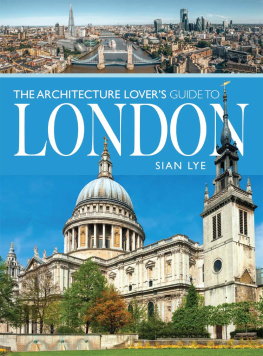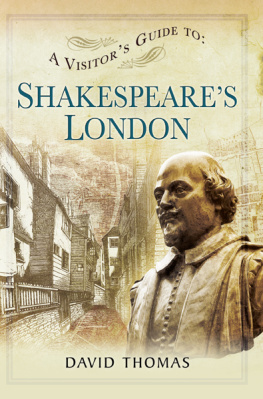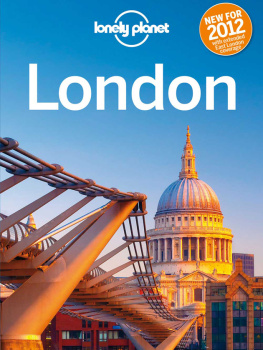Pagebreaks of the print version

THE ARCHITECTURE LOVERS GUIDE TO
LONDON
For Jim, Zoe & Erin
First published in Great Britain in 2022 by
White Owl
An imprint of
Pen & Sword Books Ltd
Yorkshire - Philadelphia
Copyright Sian Lye, 2022
ISBN 978 1 39900 166 3
eISBN 978 1 39900 167 0
Mobi ISBN 978 1 39900 167 0
The right of Sian Lye to be identified as author of this work has been asserted by her in accordance with the Copyright, Designs and Patents Act 1988.
All photographs Adobe Stock apart from where otherwise indicated.
A CIP catalogue record for this book is available from the British Library.
All rights reserved. No part of this book may be reproduced or transmitted in any form or by any means, electronic or mechanical including photocopying, recording or by any information storage and retrieval system, without permission from the Publisher in writing.
Pen & Sword Books Ltd incorporates the imprints of Pen & Sword Books Archaeology, Atlas, Aviation, Battleground, Discovery, Family History, History, Maritime, Military, Naval, Politics, Railways, Select, Transport, True Crime, Fiction, Frontline Books, Leo Cooper, Praetorian Press, Seaforth Publishing, Wharncliffe and White Owl.
For a complete list of Pen & Sword titles please contact
PEN & SWORD BOOKS LIMITED
47 Church Street, Barnsley, South Yorkshire, S70 2AS, England
E-mail:
Website: www.pen-and-sword.co.uk
Or
PEN AND SWORD BOOKS
1950 Lawrence Rd, Havertown, PA 19083, USA
E-mail:
Website: www.penandswordbooks.com
INTRODUCTION
SINCE ITS EARLY days as rolling hills and streams, London has come a long way to be one of the most exciting and innovative cities in the world.
While its impossible to mention all the incredible buildings that have stood in the capital, this Guide looks at key structures throughout the ages that exemplify the style of the time or have a significance for the city.
From the Romans first settlement 2,000 years ago, which rose and fell several times before the Roman Empire itself fell, we can still see evidence of their architectural endeavours in amongst the enormously sophisticated buildings of today.
During the Anglo-Saxon period the capital saw more than its fair share of attacks and fighting until the Normans gained power and again started building with purpose. The area boomed under the Tudors and expanded at such pace that the city spilled into the area around the original site of London for the first time.
Houses of Parliament and Big Ben.

By the end of the sixteenth century, more of Londons population lived outside the city walls than inside them. The Tudors timber framed wattle and daub checkerboard houses proliferated.
The Stuart period of the seventeenth century, saw a London that was thriving, with Inigo Jones introducing the classical style of Europe to the city with his magnificent buildings.
The Great Fire struck in 1666, destroying nearly 90 percent of the medieval buildings, but rather than seeing this as a setback, it was used as an opportunity to reimagine the structure of the city. From the ashes rose the magnificent form of St Pauls Cathedral seen today, courtesy of Sir Christopher Wren.
During the Georgian period, London dramatically increased in size again and the style of architecture changed, with the creation of beautiful townhouses, including 10 Downing Street, which would become home for subsequent Prime Ministers.
The Regency period brought new changes, with the prolific architect John Nash designing some of the most famous buildings in London today, including Buckingham Palace and Marble Arch. Victorian Britain was a period of enormous growth, with London becoming a political and financial hub, producing too many innovations and architectural triumphs to mention.
At the advent of the twentieth century there was a change in architectural taste, new materials and grand plans, and Art Deco soon exploded on to the architectural scene.
After the Second World War, London was in desperate need of repair. This devastation was again used as an opportunity to create a better city.
The 1970s brought postmodernism and high tech to architecture in London, and since the Millennium, there has been a wave of spectacular buildings continuing the legacy of original and revolutionary architecture in the capital.
The history of London is a story of experimentation, determination and triumph. A city at the cutting edge of style and fashion, rising from every fire, every attack, every setback. No one can say what the future will hold for the architecture of this fascinating city, but it will almost certainly be surprising, and definitely one to watch.
The London skyline.

LONDINIUM
In ancient times, the area that is now the modern and bustling city of London was mile upon mile of peaceful rolling countryside, crisscrossed with streams. The Romans arrived in AD43 and started building transforming this tranquil area into Londinium. However, a battle with Boudica saw the new settlement razed to the ground and in its place a more ordered city rose from the ashes. Eventually the London Wall superstructure was built as a defence around the city, and remnants still survive today.
After the invasion nearly 2,000 years ago, Londinium was quickly established as a settlement by the Romans. The city was developed around the area on the River Thames narrow enough to allow the construction of a bridge, but deep enough to handle the seagoing ships of the period, and the remains of an enormous pier base for such a structure were found in 1981 close to the modern London Bridge.
Indeed, evidence suggests the settlement dates back to AD47. A timber drain by the side of the main Roman road excavated at No 1 Poultry has been dated by dendrochronology to this year, thought to be the foundation date of the city.
Following its inception, early Roman London occupied a relatively small area, around 1.4 square kilometres or roughly the area of present-day Hyde Park, and was an area buzzing with activity.
Archaeologists have uncovered numerous goods imported from across the Roman Empire in this period, suggesting that early Roman London was a highly cosmopolitan community of merchants from across the Empire and that local markets existed for such objects.
All was going well for the Roman settlers, but there were problems afoot.
In AD60 or AD61, a little more than ten years after Londinium was founded, the king of the Iceni, a Brittonic tribe set in the east of Britain, died. Until this point the tribe had been largely allowed to live independently, but the death of their king Prasutagus set the country into chaos.

















